Assessment of the Combined Risk of Drought and High-Temperature Heat Wave Events in the North China Plain during Summer
Abstract
:1. Introduction
2. Data and Methods
2.1. Study Area
2.2. Data Sources
2.3. Methodology
2.3.1. Crop Water Stress Index (CWSI)
2.3.2. Standardized Precipitation Evapotranspiration Index (SPEI)
2.3.3. Identification of High-Temperature Heat Wave Events
2.3.4. Drought-Induced Risk Index
2.3.5. Combined-Events Risk Index of Drought and High-Temperature Heat Waves
2.3.6. Other Methods
3. Results and Analysis
3.1. Drought Variation Characteristics Based on the SPEI and CWSI
3.2. Temporal and Spatial Variation Characteristics of High-Temperature Heat Waves
3.3. Spatial and Temporal Variation Characteristics of Drought-Induced Risk
3.4. Spatiotemporal Variation in Combined-Events Risk of Drought and High-Temperature Heat Waves
4. Discussion
5. Conclusions
Author Contributions
Funding
Data Availability Statement
Conflicts of Interest
References
- Wang, J.S.; Li, Y.H.; Wang, R.Y.; Feng, J.Y.; Zhao, Y.X. Preliminary Analysis on the Demand and Review of Progress in the Field of Meteorological Drought Research. J. Arid. Meteorol. 2012, 30, 497–508. [Google Scholar]
- Yao, Y.B.; Zhang, Q.; Li, Y.H.; Wang, Y.; Wang, J.S. Drought Risk Assessment Technological Progresses and Problems. Resour. Sci. 2013, 35, 1884–1897. [Google Scholar]
- Xu, J.W.; Ju, H.; Liu, Q.; Yang, J.Y. Variation of Drought and Regional Response to Climate Change in Huang-Huai-Hai Plain. Acta Ecol. Sin. 2014, 34, 460–470. [Google Scholar]
- Ma, Z.G.; Hua, L.J.; Ren, X.B. The Extreme Dry/Wet Events in Northern China During Recent 100 Years. Acta Geogr. Sin. 2003, 58, 69–74. [Google Scholar]
- Zhang, X.Z.; Zheng, J.Y.; Hao, Z.X. Climate Change Assessments for the Main Economic Zones of China During Recent Decades. Prog. Geogr. 2020, 39, 1609–1618. [Google Scholar] [CrossRef]
- Baldwin, J.W.; Dessy, J.B.; Vecchi, G.; Oppenheimer, M. Temporally Compound Heat Wave Events and Global Warming: An Emerging Hazard. Earth’s Future 2019, 7, 411–427. [Google Scholar] [CrossRef]
- Sun, Y.J.; Liu, X.F.; Ren, Z.Y.; Duan, Y.F. Spatiotemporal Changes of Droughts and Heatwaves on the Loess Plateau During 1960–2016. Prog. Geogr. 2020, 39, 591–601. [Google Scholar] [CrossRef]
- Wang, C.; Li, Z.; Chen, Y.; Li, Y.; Liu, X.G.; Hou, Y.F.; Wang, X.C.; Kulaixi, Z.; Sun, F. Increased Compound Droughts and Heatwaves in A Double Pack in Central Asia. Remote. Sens. 2022, 14, 2959. [Google Scholar] [CrossRef]
- Shi, Z.T.; Jia, G.S.; Zhou, Y.Y.; Xu, X.Y.; Jiang, Y. Amplified Intensity and Duration of Heatwaves by Concurrent Droughts in China. Atmos. Res. 2021, 261, 105743. [Google Scholar] [CrossRef]
- Heim, J.; Richard, R. A Review of Twentieth-Century Drought Indices Used in the United States. Bull. Am. Meteorol. Soc. 2002, 83, 1149–1165. [Google Scholar] [CrossRef]
- Ma, S.Q.; Zhang, B.; Zhang, J.Q.; Pan, Z.H.; Wu, Q.H.; Huang, H.; Yang, M. Applicability Analysis of Standardized Precipitation Evapotranspiration Index in North China Plain. Chin. J. Agric. Resour. Reg. Plan. 2020, 41, 235–245. [Google Scholar]
- Yang, X.Y.; Li, D.L. Temporal and Spatial Evolution Characteristics of Strong Drought Events in North and Northeast China. Arid. Land Geogr. 2019, 42, 810–821. [Google Scholar]
- Wei, X.Y.; Hu, Q.; Ma, X.Q.; Zheng, S.R.; Tang, X.N.; Zhang, Y.Y.; Pan, X.B.; He, Q.J. Temporal-Spatial Variation Characteristics of Drought in Summer Maize Growing Season in North China Plain Based on SPEI. J. Arid. Meteorol. 2018, 36, 554–560. [Google Scholar]
- Yang, S.Y.; Meng, D.; Li, X.J.; Wu, X.L. Multi-Scale Responses of Vegetation Changes Relative to the SPEI Meteorological Drought Index in North China in 2001–2014. Acta Ecol. Sin. 2018, 38, 1028–1039. [Google Scholar]
- Jackson, R.D.; Idso, S.B.; Reginato, R.J.; Pinter, P.J. Canopy Temperature as A Crop Water Stress Indicator. Water Resour. Res. 1981, 17, 1133–1138. [Google Scholar] [CrossRef]
- Wang, Z.; Wang, F.; Zhang, Y. Spatio-temporal Distribution Characteristics and Influencing Factors of Drought in Anhui Province Based on CWSI. J. Nat. Resour. 2018, 33, 853–866. [Google Scholar]
- Wang, Y.J.; Wang, S.D.; Zeng, H.J.; Cai, M.Y.; Song, W.L. Drought Characteristic in the Weihe River Basin Based on Water Shortage Index of Crops. Arid. Zone Res. 2014, 31, 118–124. [Google Scholar]
- Yu, Y. Comparison of Drought Monitoring and Study on Spatial and Temporal Characteristics of Drought in Guanzhong Area Based on CWSI and TVDI; Shaanxi Normal University: Shaanxi, China, 2015; pp. 1–69. [Google Scholar]
- Wu, T.X.; Li, B.F.; Guo, H.; Wang, Y.Q.; Zhu, Y.B.; Lian, L.S. Analysis of Drought Variation Characteristics in North China Plain Based on Optimized Remote Sensing Drought Index. Acta Ecol. Sin. 2021, 43, 1–14. [Google Scholar] [CrossRef]
- Liu, X.F.; Fu, B.J. Drought Impacts on Crop Yield: Progress, Challenges and Prospect. Acta Geogr. Sin. 2021, 76, 2632–2646. [Google Scholar]
- Li, H.Y.; Zhang, X.Y.; Wang, J.; Zheng, G.F.; Wang, S.Y. Analysis of Drought Disasters-Causing Factors in Ningxia Based on CI Index. Plateau Meteorol. 2014, 33, 995–1001. [Google Scholar]
- Xie, G.D. Agricultural Drought Risk Assessment and Regionalization in Ji’an City; Nanchang University: Nanchang, China, 2020; pp. 1–101. [Google Scholar]
- Li, N.; Huo, Z.G.; Qian, J.X.; Zhou, X.Y.; Shi, Y.X. Risk Analysis and Zoning of Drought Disaster in Shanxi. Chin. J. Agric. Resour. Reg. Plan. 2021, 42, 100–107. [Google Scholar]
- Wang, X.L.; Zhang, C.Y.; Hou, X.Y. Spatial-Temporal Characteristics and Hazard Risks of Meteorological Drought in Circum-Bohai-Sea region from 1961 to 2017. Acta Ecol. Sin. 2019, 39, 4647–4659. [Google Scholar]
- Ansari, A.A.; Aghighi, H.; Lopez-Baeza, E. Drought Risk Evaluation in Iran by Using Geospatial Technologies. Remote. Sens. 2022, 14, 3096. [Google Scholar] [CrossRef]
- He, S.F.; Dai, E.F.; Ge, Q.S.; Wu, S.H.; Li, M.Q. Pre-estimation of Spatiotemporal Pattern of Extreme Heat Hazard in China. J. Nat. Disasters 2010, 19, 91–97. [Google Scholar]
- Deng, Z.Y.; Wen, X.H.; Huang, T.; Zhang, H.; Xi, L.Z.; Xu, J.F.; Dong, A.X. Relationship and Difference Between Drought and High Temperature Heat Waves. Plateau Meteorol. 2009, 28, 702–709. [Google Scholar]
- Hao, Z.C.; Hao, F.H.; Singh, V.P.; Zhang, X. Changes in the Severity of Compound Drought and Hot Extremes over Global Landareas. Environ. Res. Lett. 2018, 13, 124022. [Google Scholar] [CrossRef]
- Miralles, D.G.; Gentine, P.; Seneviratne, S.I.; Teuling, A.J. Land–atmospheric Feedbacks during Droughts and Heatwaves: State of the Science and Current Challenges. Ann. N. Y. Acad. Sci. 2019, 1436, 19–35. [Google Scholar] [CrossRef]
- Sutanto, S.G.; Sutanto, C.; Napoli, C.D.; Andrea, M.D. Heatwaves, Droughts, and Fires: Exploring Compound and Cascading Dry Hazards at the Pan-European Scale. Environ. Int. 2020, 134, 105276. [Google Scholar] [CrossRef]
- Tavakol, A.; Rahmani, V.; Harrington, J. Probability of Compound Climate Extremes in a Changing Climate: A Copula-based Study of Hot, Dry, and Windy Events in the Central United States. Environ. Res. Lett. 2020, 15, 104058. [Google Scholar] [CrossRef]
- Weber, T.; Bowyer, P.; Rechid, D.; Pfeifer, S.; Raffaele, F.; Remedio, A.R.; Teichmann, C.; Jacob, D. Analysis of Compound Climate Extremes and Exposed Population in Africa under Two Different Emission Scenarios. Earth’s Future 2020, 8, 1–19. [Google Scholar] [CrossRef]
- Wu, X.Y.; Hao, Z.C.; Hao, F.H.; Li, C.; Zhang, X. Spatial and Temporal Variations of Compound Droughts and Hot Extremes in China. Atmosphere 2019, 10, 95. [Google Scholar] [CrossRef]
- Vicente-Serrano, S.M.; Beguería, S.; López-Moreno, J.I. A Multiscalar Drought Index Sensitive to Global Warming: The Standardized Precipitation Evapotranspiration Index. J. Clim. 2010, 23, 1696–1718. [Google Scholar] [CrossRef]
- Wang, C.Z.; Mao, L.X.; Lv, H.Q.; Chen, J.; Yu, Z.R. Remote Sensing Monitoring of Regional Drought Based on Crop Water Shortage Index; Chinese Meteorological Society: Guangzhou, China, 2007; pp. 1183–1192. [Google Scholar]
- Ma, Z.C.; Sun, P.; Zhang, Q.; Hu, Y.Q.; Jiang, W. Characterization and Evaluation of MODIS-Derived Crop Water Stress Index (CWSI) for Monitoring Drought from 2001 to 2017 over Inner Mongolia. Sustainability 2021, 13, 916. [Google Scholar] [CrossRef]
- Zhang, Y.J.; Wang, C.Y.; Zhang, J.Q. Analysis of the Spatial and Temporal Characteristics of Drought in the North China Plain Based on Standardized Precipitation Evapotranspiration Index. Acta Ecol. Sin. 2015, 35, 7097–7107. [Google Scholar]
- Zhou, D.; Zhang, B.; Luo, J.; Zhang, C.L.; An, M.L.; Wang, D. SPEI-Based Intensity Characteristics and Cause Analysis of Drought in North China During Recent 50 Years. J. Nat. Disasters 2014, 23, 192–202. [Google Scholar]
- Li, W.G.; Hou, M.T.; Chen, H.L.; Chen, X.M. Study on Drought Trend in South China Based on Standardized Precipitation Evapotranspiration Index. J. Nat. Disasters 2012, 21, 84–90. [Google Scholar]
- Xu, J.F.; Deng, Z.Y.; Chen, M. A Summary of Studying on Characteristics of High Temperature and Heat Wave Damage in China. J. Arid. Meteorol. 2009, 27, 163–167. [Google Scholar]
- Wang, W.; Hu, Y.J.; Xu, C.Y. Spatial-Temporal Variations of Heat Waves in the Huaihe River Basin from 1961 to 2018. Sci. Geogr. Sin. 2021, 41, 911–921. [Google Scholar]
- Gocic, M.; Trajkovic, S. Analysis of Changes in Meteorological Variables Using Mann-Kendall and Sen’s Slope Estimator Statistical Tests in Serbia. Glob. Planet. Chang. 2013, 100, 172–182. [Google Scholar] [CrossRef]
- Bian, Y.J.; Sun, P.; Zhang, Q.; Luo, M.; Liu, R.L. Amplify of Non-Stationary Drought to Heatwave Duration and Intensity in Eastern China: Spatiotemporal Pattern and Causes. J. Hydrol. 2022, 612, 128154. [Google Scholar] [CrossRef]
- Luo, M.; Ngar-Cheung, L. Amplifying Effect of ENSO on Heat Waves in China. Clim. Dyn. 2019, 52, 3277–3289. [Google Scholar] [CrossRef]
- Liu, Q.; Zhou, T.J.; Mao, H.T.; Fu, C.B. Decadal Variations in the Relationship between the Western Pacific Subtropical High and Summer Heat Waves in East China. J. Clim. 2019, 32, 1627–1640. [Google Scholar] [CrossRef]

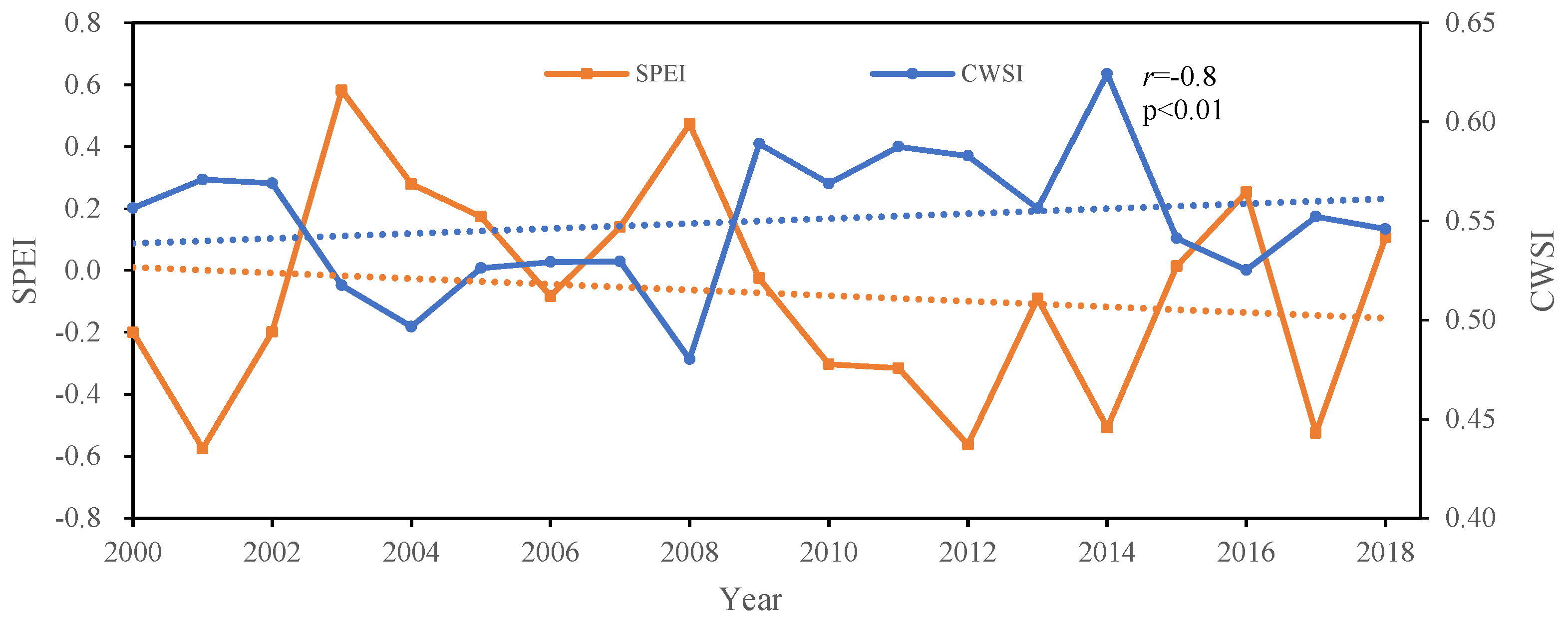



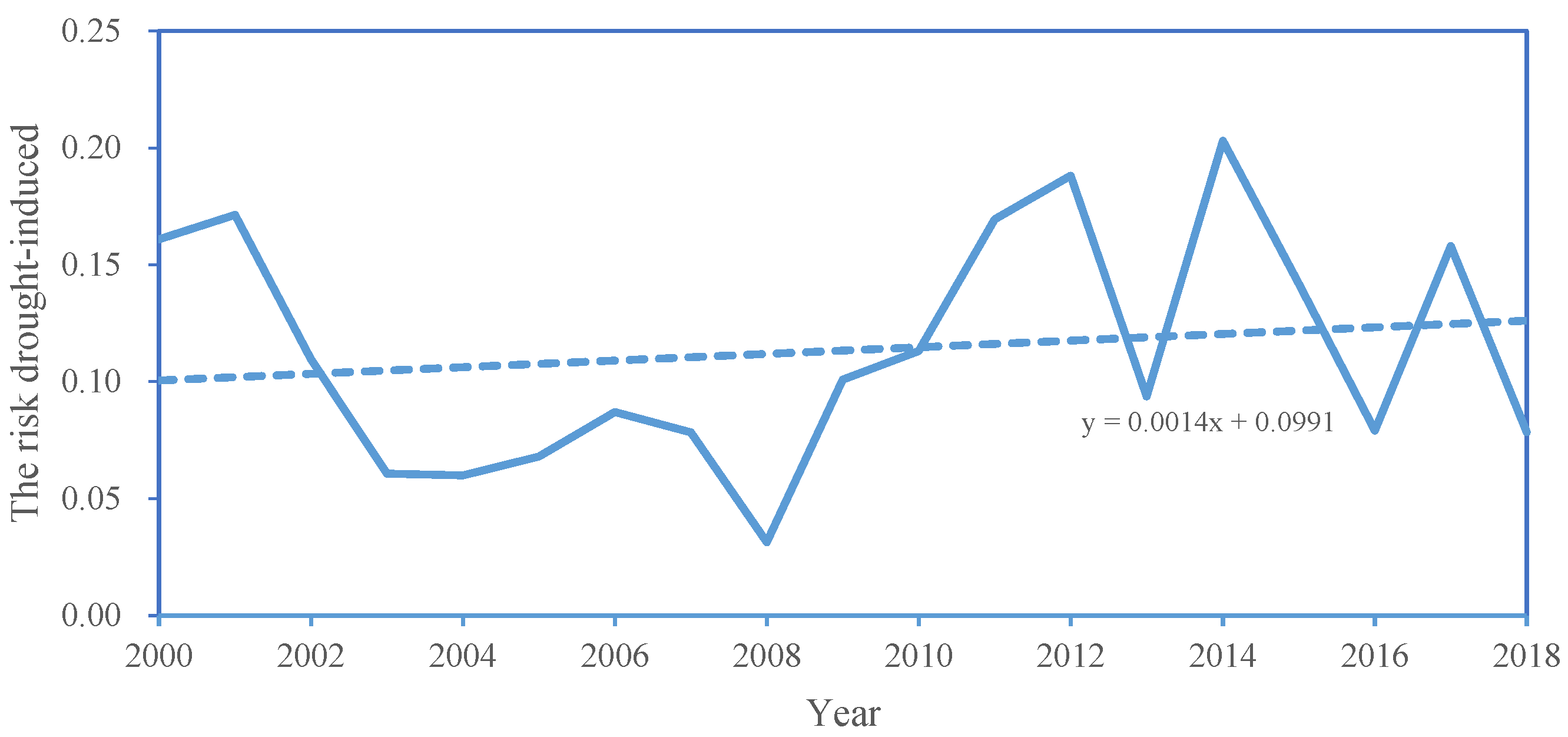

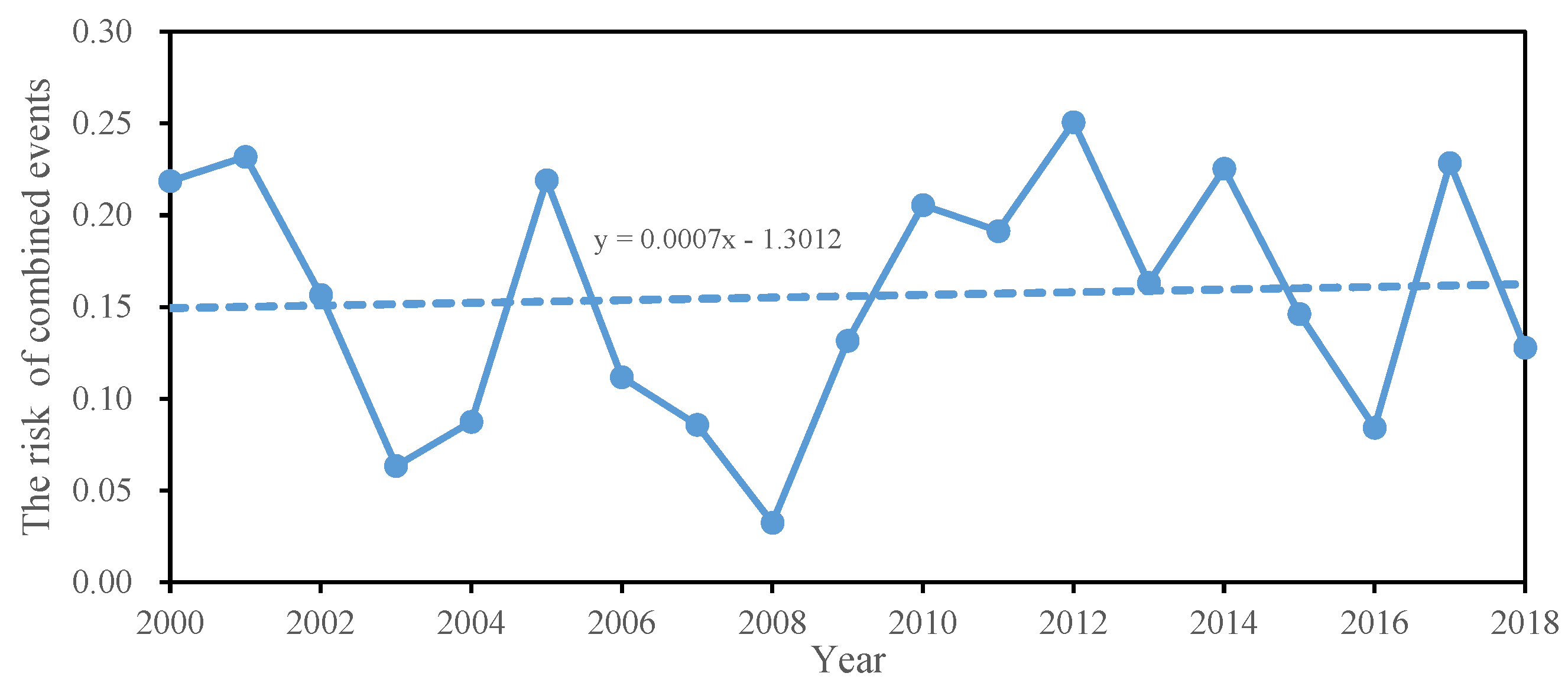
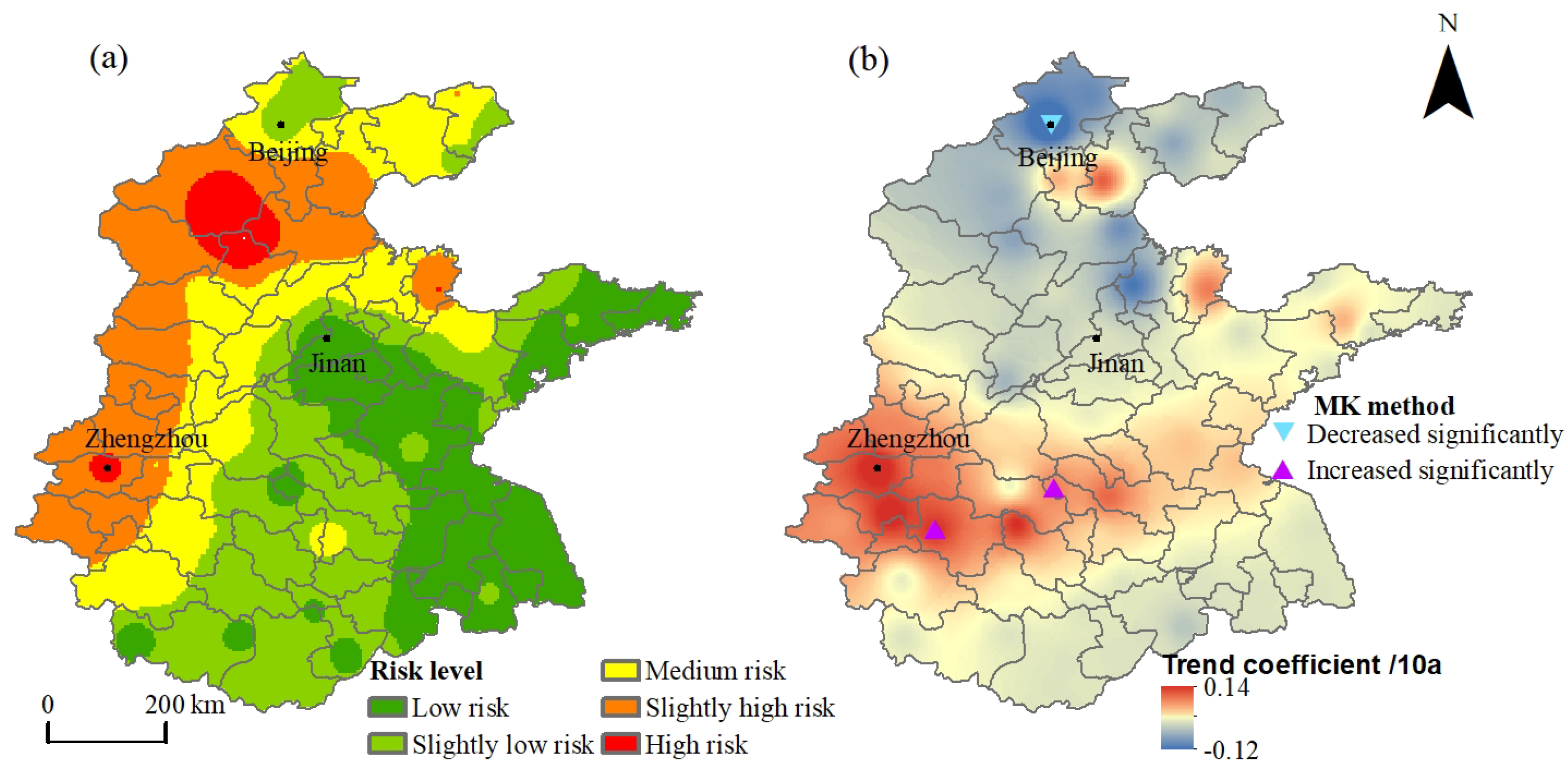
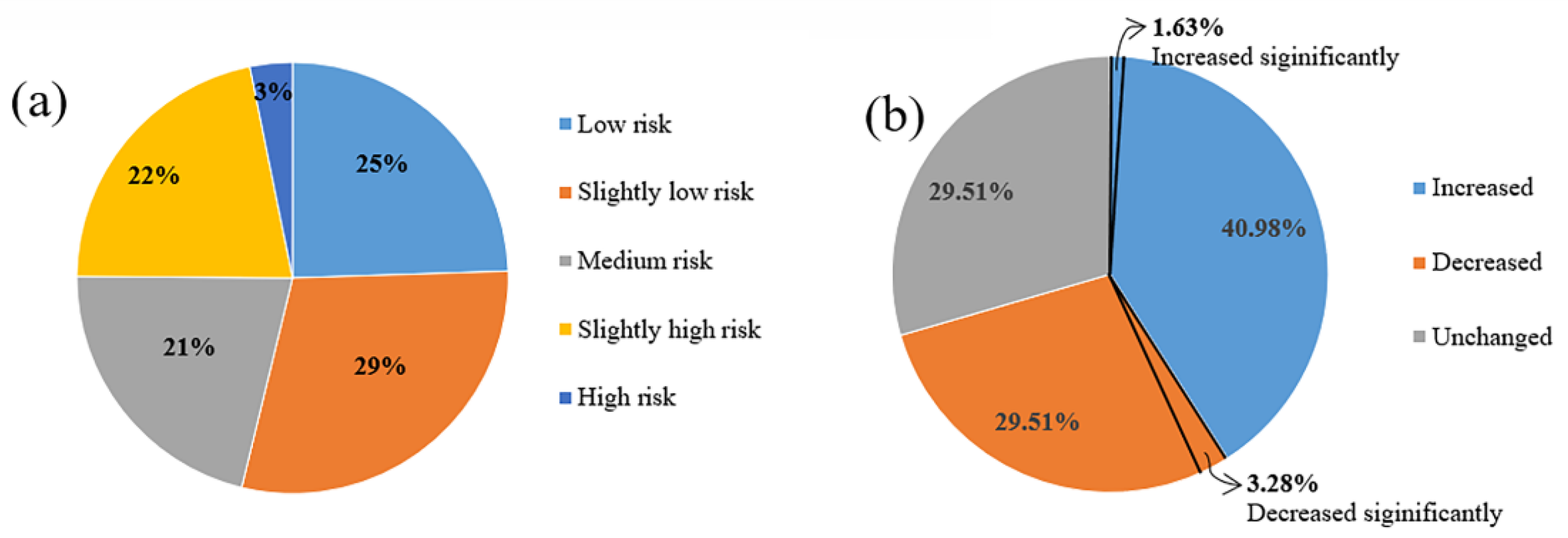
| r | SPEI-1 | SPEI-3 | SPEI-6 | CWSI |
|---|---|---|---|---|
| 10 cm | 0.59 | 0.64 | 0.48 | −0.61 |
| 20 cm | 0.48 | 0.59 | 0.45 | −0.55 |
| 50 cm | 0.30 | 0.49 | 0.43 | −0.51 |
Publisher’s Note: MDPI stays neutral with regard to jurisdictional claims in published maps and institutional affiliations. |
© 2022 by the authors. Licensee MDPI, Basel, Switzerland. This article is an open access article distributed under the terms and conditions of the Creative Commons Attribution (CC BY) license (https://creativecommons.org/licenses/by/4.0/).
Share and Cite
Wu, T.; Li, B.; Lian, L.; Zhu, Y.; Chen, Y. Assessment of the Combined Risk of Drought and High-Temperature Heat Wave Events in the North China Plain during Summer. Remote Sens. 2022, 14, 4588. https://doi.org/10.3390/rs14184588
Wu T, Li B, Lian L, Zhu Y, Chen Y. Assessment of the Combined Risk of Drought and High-Temperature Heat Wave Events in the North China Plain during Summer. Remote Sensing. 2022; 14(18):4588. https://doi.org/10.3390/rs14184588
Chicago/Turabian StyleWu, Tianxiao, Baofu Li, Lishu Lian, Yanbing Zhu, and Yanfeng Chen. 2022. "Assessment of the Combined Risk of Drought and High-Temperature Heat Wave Events in the North China Plain during Summer" Remote Sensing 14, no. 18: 4588. https://doi.org/10.3390/rs14184588
APA StyleWu, T., Li, B., Lian, L., Zhu, Y., & Chen, Y. (2022). Assessment of the Combined Risk of Drought and High-Temperature Heat Wave Events in the North China Plain during Summer. Remote Sensing, 14(18), 4588. https://doi.org/10.3390/rs14184588











